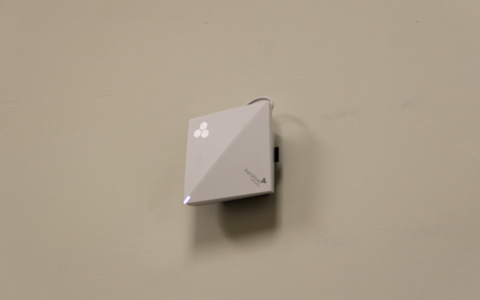Upgrading the Wireless Network
 A good Wi-Fi connection drives everything at W&M, from checking assignments on Blackboard to sending emails. That is why the university is currently in the middle of a huge wireless upgrade, which will help ensure reliable connectivity for students, faculty, and staff alike.
A good Wi-Fi connection drives everything at W&M, from checking assignments on Blackboard to sending emails. That is why the university is currently in the middle of a huge wireless upgrade, which will help ensure reliable connectivity for students, faculty, and staff alike.
Initial research for this project started because over the years, more students were bringing more devices such as phones and tablets, with 89% of students connecting at least two or more devices to the network. "Our current network was designed several years ago. We simply could not anticipate the quantity of applications and devices students would use today,” explains Norman Elton, network engineer, who is one of the main people behind the new upgrade. Elton leads a team that includes IT Networking staff member, Matt Kennedy, and multiple contractors to work through the 80+ buildings on campus that are set to receive the new access points.
A New Location for Access Points
One of the biggest changes that the wireless upgrade will bring are new locations for access points, which will keep the signal more contained. This will be possible because access points will be moving from the hallways in residence halls to individual rooms. In the past, they were located above the ceilings in residence halls, but the switch to individual rooms will be more ideal.
“When installed in a residence room, access points can serve clients in the immediate vicinity,” said Elton. “The big change is that when the access points are in the hallway, there are two or three of them in a whole hallway, so you’d have 20-40 people on three access points.”
What this means is that the Wi-Fi will ultimately be faster and more stable because it will target four people per access point instead of 20 people per access point. “By putting the access points in the rooms, it keeps the signal contained, so you get great signal in your room,” said Elton. Even corner rooms, that traditionally got a weaker signal, will be covered. “In the past, people that lived in the corner rooms got a weaker signal since they were farther away [from the access points]. To address this problem, we installed more access points, but being limited to the hallway, we could only make it but so good. But now by having an access point nearby, you should have excellent coverage.”
Traditionally, there were three to five access points in the hallways, but now students’ computers or tablets will be able to pick the best access point out of two or three possible options. In fact, during the testing phase of this project, this capability was one of the main aspects that was tested in Old Dominion Hall. In addition, the decision had to be made on whether or not to continue with the university’s current vendor, Aerohive, or to possibly consider a different vendor. In the fall of 2015, both of these vendors were also tested in Old Dominion, but Aerohive continued to give the best performance.
Upgrading the Wireless Protocol
In addition to the new locations of access points, another component of the project is the addition of an updated wireless protocol. According to Elton, “people were showing up with laptops that were newer than what our network could support, so they were connected to the older speeds. But now we are bumping up to the latest technology.”
Fundamentally, this meant that it was time for a wireless standard that would be able to support the newer laptops and technology. While these current pieces of technology could still use the old standard, it was not optimal. Scott Fenstermacher, network manager, expressed: “meeting modern technology standards and preparing for the needs of the future is a continued goal in IT.”
Residence hall upgrades were finished in the end of June. Work in the academic buildings and administrative areas will commence in July. The project can expect to be completed by the end of December of 2016.
 Skip to main content
Skip to main content
